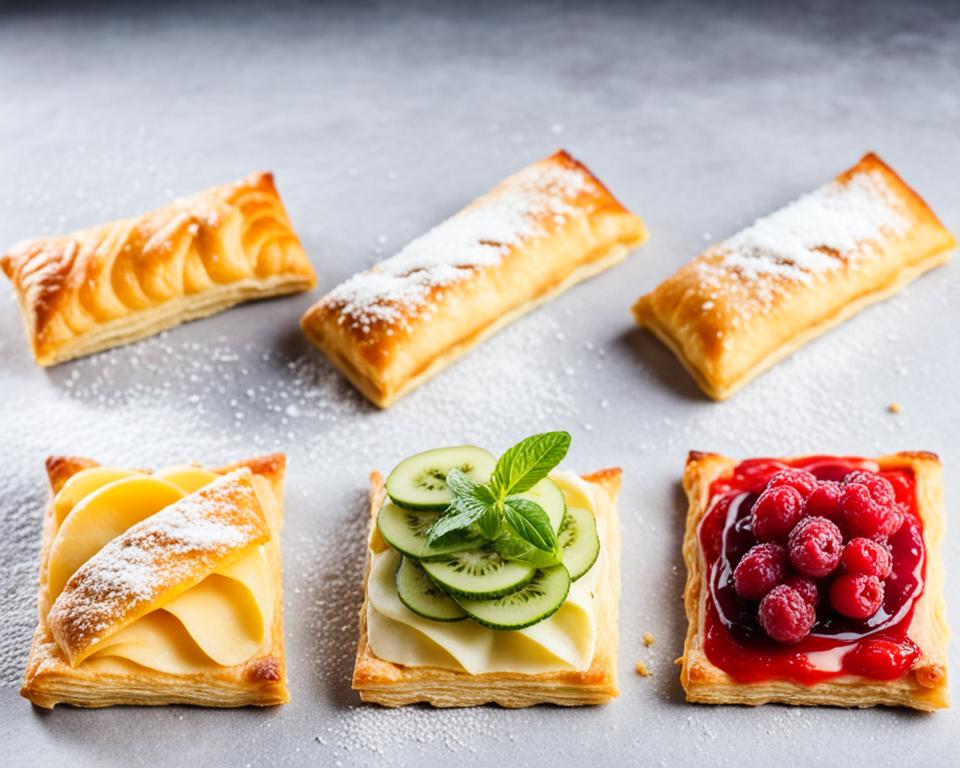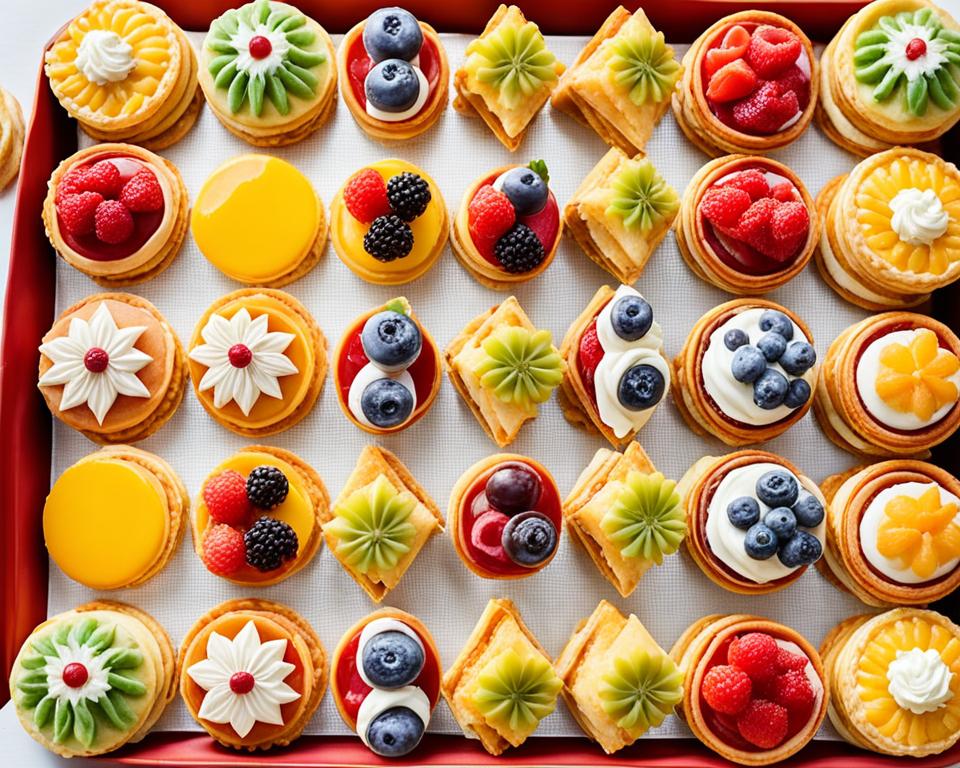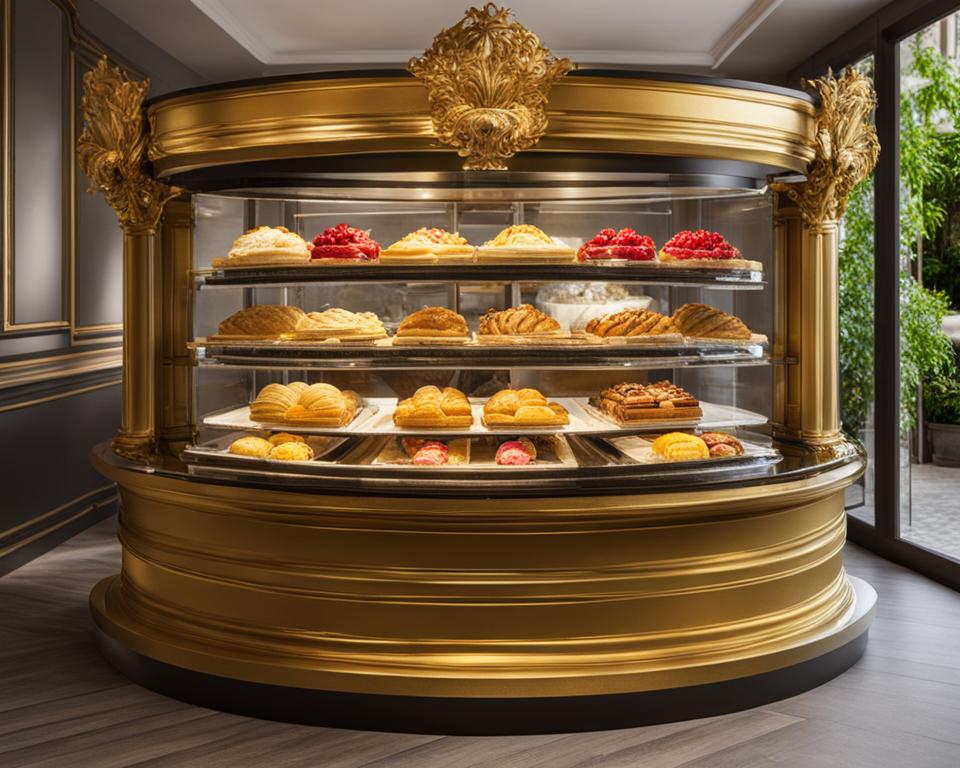Whether you’re a seasoned baker or a curious culinary enthusiast, understanding the types of puff pastry is essential for achieving the perfect flake and flavor in your baked creations. From the airy layers of classic patisserie to the homemade delights of kitchen baking, puff pastry varieties are as diverse as they are delicious. This article will provide a puff pastry comparison to help distinguish between the best puff pastry options for your next mouthwatering project.
Key Takeaways
- Types of puff pastry include full, three-quarter, and half, each providing a unique baking experience and outcome.
- Understanding the puff pastry varieties is crucial for selecting the appropriate option for different recipes and desired textures.
- Whether for savory applications or sweet delights, knowing the best puff pastry options will enhance the final baked good.
- A well-informed puff pastry comparison assists bakers in achieving the desired flakiness and taste for their culinary creations.
- Each puff pastry type offers a different ratio of fat to flour, impacting the pastry’s richness and layers.
- By exploring the various puff pastry types, bakers can expand their repertoire and confidently experiment with new recipes.
- Choosing the right puff pastry variety amplifies the overall quality and indulgence of the baking experience.
Understanding the Basics of Puff Pastry
Embarking on the journey of homemade puff pastry creation, one delves into a world where precision meets artistry. The quintessential puff pastry ingredients form the foundation for a laminated structure that bakers have perfected over centuries. High-protein pastry flour, water, salt, dough fat, and the all-important primary fat—typically high-quality butter or specialized pastry margarine—combine to give rise to the ever so cherished crisp, flaky pastry. It’s a culinary alchemy where science and technique intertwine, leading to the indulgent result that delightfully shatters with each bite.
Ingredients and Structure in Puff Pastry
The lamination process in baking is a meticulous sequence where the butter or fat is folded into the dough repeatedly. This repeated fat incorporation and folding is pivotal in achieving the multi-layered, airy texture synonymous with puff pastry. As the name suggests, puff pastry lamination refers to creating numerous flaky sheets, resulting in a pastry with a heavenly texture that is both delicate and satisfying.
The Lamination Process and Fat Incorporation
Mastering the lamination process in baking begins with understanding the differences in technique across the French, English, and Scotch methods. Each method presents a unique approach to puff pastry lamination, impacting the final mouthfeel and visual appeal of the pastry. The French method is characterized by its precision in encasing a pliable block of butter-flour mixture within the dough, while the English method involves layering and folding the fat and dough. In contrast, the Scotch method—a more free-form approach—distributes fat throughout the dough in chunks, fostering a rustic and uneven rise.
Culinary Science Behind Puff Pastry
At the heart of puff pastry science is the transformation of ingredients within the furnace of the oven. Expanding air in baking coupled with steam in dough elevate the laminated constructs to their maximum potential. As the pastry heats, the butter melts, and the liberated water vapor—steaming upwards—infuses life into the assembled strata of dough. Meanwhile, gluten coagulation ensures that the structural integrity of each delicate leaf is underpinned by a network strong enough to capture and maintain the majestic rise of the pastry.
Classic Puff Pastry: A Culinary Artform
The creation of traditional puff pastry is a testament to the enduring legacy of classic French patisserie. This delicate puff pastry artform requires mastery over a myriad of techniques that are steeped in history and sophistication. Bringing this artistry into the home, aspiring bakers can revel in the intricacies of preparation of puff pastry, a process that transcends the simplicity of its basic ingredients into a marvel of texture and taste.
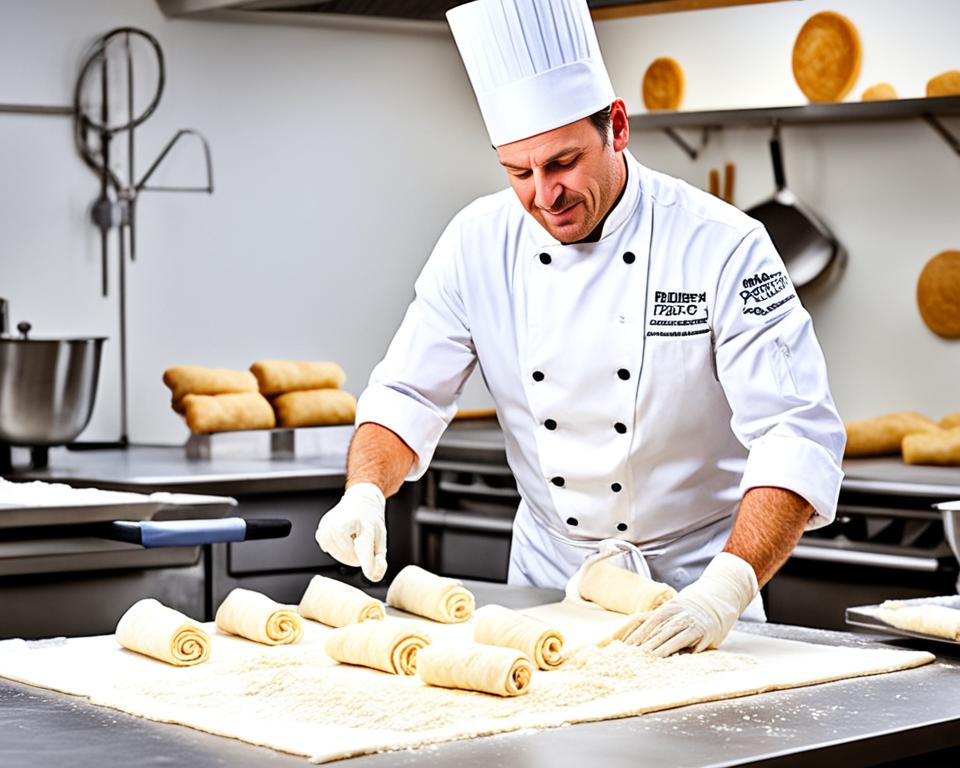
Traditional Techniques in Puff Pastry Making
At the heart of creating homemade puff pastry lies the deft manipulation of dough and fat. One not only juggles with ingredients but also with time and temperature. In practicing the French pâtisserie techniques, bakers learn to cherish the coldness of the butter, the elasticity of the dough, and the meticulous rolling and folding that lead to the formation of hundreds of desirable layers.
From French Pâtisserie to Your Kitchen
While it may seem daunting, the fine art of baking puff pastry at home is attainable with patience and persistence. Inspired by the classic French patisserie, the realms of personal kitchens now echo the pursuit of perfection that was once confined to professional boulangeries. From sweet mille-feuilles to savory vol-au-vents, mastering the preparation of puff pastry empowers home cooks to create an array of exquisite baked goods that speak volumes of their culinary dedication.
| Technique | Lamination Steps | Resting Time | Signature Quality |
|---|---|---|---|
| French Method | Butter block encased in dough | 20-30 minutes between turns | Even, delicate layers |
| English Method | Layered butter and dough | 30 minutes between turns | Rich flavor, voluminous rise |
| Scotch Method | Fat in chunks within dough | Less resting needed | Rustic, uneven layers |
What are the 3 types of puff pastry?
Connoisseurs of fine baking, take heed as we delve into the layers of the crumbly enigma that is puff pastry. Renowned for its buttery richness and flaky texture, puff pastry is a beloved classic in the baking world. With its versatility in culinary uses, it’s no surprise that chefs and home bakers seek to understand the variations in this staple ingredient. Let’s explore together the three primary types of puff pastry, each offering distinct features suited to specific culinary tasks.
When discussing what are the 3 types of puff pastry, it’s critical to recognize how fat content relative to flour shapes the pastry’s character. We start with the full puff pastry, a luxurious option where fat and flour are used in equal measure, crafting a rich taste and producing numerous airy layers that puff vigorously upon baking. It’s the go-to choice when indulgence is key, and only the most voluptuous pastry will suffice.
Moving on to the slightly leaner yet equally delightful three-quarter puff pastry. This variant lowers the fat proportion just enough to preserve a decadent flavor without compromising the sought-after flakiness. In a quest for balance between richness and subtlety, the three-quarter puff strikes a chord, offering a harmonious mouthfeel perfect for elegant desserts and savory dishes alike.
Finally, we encounter the half puff pastry, characterized by a fat content that’s half the weight of the flour. This version is tailored for those who prefer a lighter flake and a more temperate taste. Best suited for airy treats where the filling is meant to shine, its delicate layers are delightfully crisp yet tender, making it a versatile companion in the kitchen.
Puff pastry brands often provide pre-made versions of these types, catering to individuals eager to indulge in the pleasures of store-bought puff pastry. The availability of such products has revolutionized home baking, allowing even the novice baker to produce professional-grade pastries with relative ease.
Whether you choose to go the route of homemade or explore the myriad of puff pastry options available in the aisles, each type of puff pastry imparts its character onto your culinary canvas. Below is a table simplifying the nuances that define full, three-quarter, and half puff pastry.
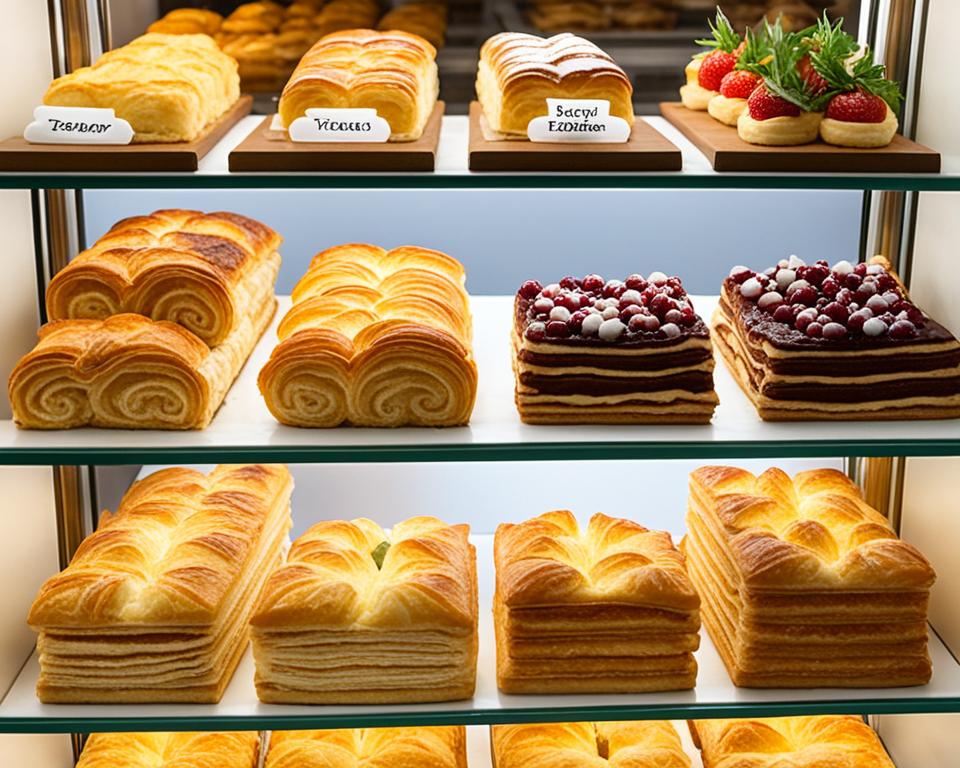
| Type of Puff Pastry | Fat to Flour Ratio | Typical Uses | Mouthfeel and Texture |
|---|---|---|---|
| Full Puff | 1:1 | Vol-au-vents, high-end pastries | Extremely flaky, buttery |
| Three-Quarter Puff | 3:4 | Tarts, turnovers | Balance of flakiness and tenderness |
| Half Puff | 1:2 | Light pastry cases, appetizers | Light flake, subtler butter flavor |
In conclusion, understanding the types of puff pastry enriches your baking endeavors, opening doors to a greater variety of textures and flavors. Now that you’re familiar with each category, you’re well-equipped to make informed decisions regarding puff pastry options. So whether you’re a professional chef or a baking enthusiast, use this newfound knowledge to craft extraordinary creations that cater to every palate.
Methods to Master Perfect Puff Pastry
Embarking upon the journey to master the intricate process of making perfect puff pastry, one must familiarize themselves with a variety of lamination techniques. Each method plays a pivotal role in the pastry’s final texture, flavor, and appearance, with the French, English, and Scotch methods standing out as cornerstones within the vast realm of French pastry techniques. From the sublime layers of traditional puff pastry to the more expedited approach of rough puff pastry, understanding and applying these methods is key to one’s culinary success.
French vs. English vs. Scotch Methods
The French pastry technique is revered for its elegance and precision, involving methodical rolling and folding to encase a pliable butter block within the dough. Patience and attention to detail are paramount here as one aims to create those flawless, uniform layers that puff pastry is renowned for.
Contrastingly, the English method lays out a simpler path to achieve lamination. By layering butter onto the dough before folding, this technique ensures an even distribution of fat throughout the pastry, setting the stage for a luxurious rise and rich flavor.
Meanwhile, redefining the baking experience, the Scotch method pares down the process to its basics. By integrating sizable chunks of fat directly into the dough, bakers can quickly craft a robust rough puff pastry — a less refined yet ineffably charming cousin to its more elaborate counterparts.
Redefining Puff Pastry: Flavors and Textures
As we step beyond the structured world of lamination, we uncover opportunities to innovate with puff pastry flavors and textures. Incorporating ingredients such as eggs or flavored fats can not only enhance the color but also introduce a novel spectrum of tastes.
The realm of puff pastry refinement is not one to be underestimated. From the ultra-thin leaves of a classic mille-feuille to the more substantial, bread-like layers found in croissants or Danish pastries, textures vary vastly. Mastery lies in imparting a crisp yet tender bite, with a richly flaky texture that is nothing short of exquisite. This refinement hinges on the balance and distribution of fats, the treatment of the dough, and the incorporation of innovative puff pastry methods that elevate the humble pastry sheet to a culinary masterpiece.
| Method | Fat Incorporation | Characteristic Texture | Suitable for |
|---|---|---|---|
| French | Butter block encased in dough | Extremely flaky and light | High-end pastries and desserts |
| English | Layered butter and dough | Rich and voluminous | Savory pies and tarts |
| Scotch (Rough Puff) | Chunky fat within dough | Rustic with an uneven lift | Quick home baking, pies, and pastries |
Crafting pastry with the finesse of a seasoned baker requires a combination of timeless skill and creative exploration. With the puff pastry methods detailed above, both professional chefs and home bakers can continually redefine the boundaries of puff pastry, achieving marvelous flaky textures and rich flavors that delight and inspire with each bite. Whether it be through traditional techniques or modern interpretations that push the envelope of puff pastry refinement, the art of creating this versatile dough remains an exciting and rewarding endeavor.
Conclusion
In the realm of patisserie, puff pastry stands out as an ingredient as versatile as it is challenging. To truly elevate one’s baking game, understanding the unique qualities of the three types of puff pastry—full, three-quarter, and half—can make or break a dish. Selecting the best puff pastry for your recipes is more than a choice; it’s an exercise in precision and sensibility, matching the right variant to the texture and richness required.
Enlisting tried-and-true baking tips, along with a grasp of the French, English, and Scotch methods of preparation, can bolster anyone’s ability to craft high-quality puff pastry. Much like an artist knows their mediums, a baker, too, must become intimate with their dough, the effects of butter, and the transformative power of heat. Embarking on the journey of preparing these delicate layers is akin to unlocking a treasure trove of culinary possibilities—puff pastry recipes are not just instructions, but gateways to endless creative exploration.
Whether you aspire to create the flakiest croissants, the most sumptuous tarts, or even the simplest of turnovers, your attention to the subtleties of pastry-making can result in bakes that not only look professional but also carry the essence of craftsmanship. Thus, as you continue to fold, turn, and roll, let each layer not just add volume but also bring you closer to the lofty heights of baking excellence. The art of puff pastry is an open invitation to all who endeavour to wield a rolling pin in the pursuit of baking perfection.
FAQ
What are the 3 types of puff pastry?
The three types of puff pastry are ‘full’, ‘three-quarter’, and ‘half’. ‘Full’ puff pastry uses a ratio of equal weights of fat and flour for a rich and flaky result. ‘Three-quarter’ puff uses three-quarters the amount of fat to the weight of flour, providing a slightly less decadent option. ‘Half’ puff pastry contains half the weight of fat to flour, resulting in a lighter texture with fewer layers.
What are the primary ingredients and structure in a puff pastry?
Puff pastry’s primary ingredients include high-protein pastry flour, water, salt, dough fat, and a primary fat like butter or specialized pastry margarine. Its structure is a laminated arrangement of alternating layers of dough and fat, which is essential for its expansive rise and crisp, flaky texture during baking.
Can you explain the lamination process and fat incorporation in puff pastry?
The lamination process in puff pastry involves folding and rolling the dough with fat, which creates hundreds of layers. Fat incorporation varies with techniques like the French, English, and Scotch methods. Each technique affects the distribution and layering of fat differently, playing a pivotal role in the pastry’s final texture.
What is the culinary science behind puff pastry?
The expansion of air and steam within the dough during baking is the core of puff pastry’s culinary science. As the pastry bakes, the solid fat melts, and the heat turns water into steam, inflating the layers and lifting the sheets of dough. Gluten stabilizes these layers, maintaining the pastry’s voluminous structure.
What are traditional techniques in puff pastry making?
Traditional techniques in puff pastry making encompass precise tempering of ingredients, resting the dough at appropriate intervals, and executing methodical rolling and folding to create the characteristic flaky texture. These techniques have been perfected by generations of French pâtisseries.
How have French pâtisserie techniques been adapted for home bakers?
French pâtisserie techniques have been adapted for home bakers by simplifying the processes of dough preparation, lamination, and baking while still allowing for the creation of puff pastry that rivals that of a professional bakery.
What are the key differences between the French, English, and Scotch methods for puff pastry?
In the French method, butter is encased in the dough to form precise layers. The English method layers butter on the rolled-out dough, which improves fat distribution. The Scotch method, also known as rough puff pastry, involves mixing large chunks of fat throughout the dough, yielding a quick but less refined result.
How can puff pastry flavors and textures be redefined?
Puff pastry flavors and textures can be redefined by adding ingredients like eggs or flavored fats, which can introduce new taste profiles and colors. Techniques and ingredient variations also yield different textures, from delicate, thin layers to more robust, bread-like layers found in croissants and Danish pastries.

